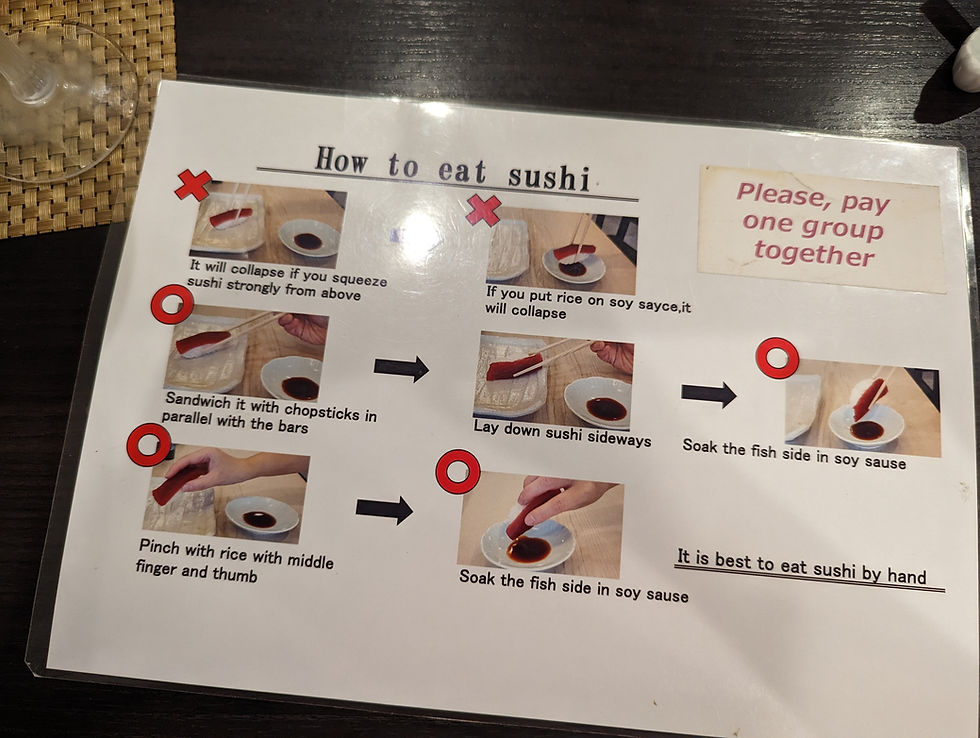Advice, Common Customs and Etiquette Tips For Visiting Japan
- Maria DiCicco

- May 9, 2023
- 5 min read
Updated: Dec 3, 2025
Whether it's your first, second, or tenth time to Japan, it's good to understand the common customs and etiquette you may encounter in the land of the rising sun.
Note: Always Pack Tissues represents many tried and tested travel sites as what is called an 'affiliate' partner. That means if you click on my ads I may get a commission from a resulting sale.
In this article you will find:
Transit Advice
When using escalators: stand on the left, pass on the right
Use proper subway etiquette and let older people or people needing extra assistance have the seat
Always wear good sneakers. There's a lot of stairs and a lot of walking in Japan.
Pack light or arrange a taxi in advance from the airports. Traveling with lots of bags around the train station is not advised due to the sheer volume of people traveling (not to mention the stairs).
Dining and Eating - Common Customs and Etiquette
Eat where you stand or where you bought the food. Eating and walking is not a thing in Japan, so you will notoriously see a lack of trash cans in public places. Eat where you purchased the food, whether it is a food stall or outside a convenience store. Save your trash in a plastic bag and dispose of it when appropriate.
Never place your chopsticks upright in your food. Common practice is to set your chopsticks down horizontally, close to your body, on a holder.
Allow someone else to pour your next glass of wine or sake. Never pour for yourself. Return the favor.
Ask someone for help with the vending machine ramen. I wanted the third ramen (from the picture) and kept hitting the three button. What I didn't realize is that I was ordering 3 bowls of number 3. Whoops. If possible, just ask for help.

Sometimes the menu is set, just go with it. This may be that the restaurant owner offers you a piece of paper with 3 prices on it, or they may say nothing at all. We had an amazing omakase meal at a mom and pop sushi restaurant, and the only question we had to answer was what to drink and which price level (sushi grade level) to purchase.
As a general rule of thumb - if it looks good, eat it. Sometimes you don't really want to know what it is until after you've tried it! Ask questions later.
Eat sushi the "right" way. Never soak the rice in soy sauce.

Don't take too long to eat at small 7-seat restaurants. Slurp up that ramen and move on, people are waiting.
Pick up your soup bowl to slurp and eat it if no spoon is provided. They didn't forget the spoon, it's on purpose.
If you slurp your soup, it's apparently a sign that it's delicious, so slurp it up!
Seek out sushi at the airport for your last meal. In the States it is not typically advised to eat airport sushi, but in this case - do it!
Clothing Advice and Etiquette
When it comes to face masks, the world has all but forgotten the endless days of masking up everywhere we went. Now, in 2024, they are still generally encouraged everywhere - especially in crowded public places, hospitals and transportation hubs. That said, although they may no longer be mandatory, always have one handy in a handbag. Follow the lead of those around you and the guidelines set out by each individual establishment.
If you are offered a yukata to wear in public hotel areas, wear it properly by tucking the right side under the left side and then tying it. Men can wear a front bow and women tend to have a flat fronted belt with the bow tucked behind.

Always wear or bring socks, just in case shoes are required to be removed at the door.
Bathroom shoes are provided in places where shoes are not worn. Slip them on to do your business and leave them for the next customer to use where you found them. (This is a great reason to always have those socks on!)
If you have tattoos, try to keep them covered up. These are symbolic of gangs in Japan and are often frowned upon.
Public Behavior
Always ask if you can take a photo of a shop vendor or other passerby on the street, if possible.
Respect that the shrines are not just photo ops for tourist, they are actually places of worship for many.
In language barrier situations, speak slowly with simpler phrases
Always hand things to someone with two hands. Present it with a little bow (almost like a thank you, or a 'here you go')
Public bathrooms almost always have a western toilet. Just wait patiently for the western stall and always check before you commit to the hole-in-the-floor style.
Use the public toilets properly. There's usually a million signs and buttons showing you what to do. There's even buttons for waterfall noises! It's ok to press the noisy buttons, it's totally common and actually preferred to cover up any gross sounds.

Always be polite and courteous
Don't be loud in public places.
Traveling to Japan with Kids
If traveling with kids, expect a lot of attention and coos of 'kawaii' (cute)
Be prepared to explain (and use) squat toilets. My three year old got a kick out of the "squirt toilets".
Bring (or buy) chopstick holders for your kids. Sometimes they will provide kiddie utensils and serve ware, but it's always good to be prepared. You can collect these at home at your local sushi restaurant.
If you have a stroller or older people traveling with you, seek out the elevators at the train stations. They're there, and will save you hundreds of steps.
Go to the convenience stores or grocery stores for milk and juice boxes or convenient (and super cute) snacks.
Stock up on cheap toys at Daiso, Seria or other 100 yen shops.
Learn more about etiquette in Japan in my children's activity book, "Scavenger Hunt Japan: A Kid's Travel Journal". With countless activities, writing prompts, challenges and more, your kids will be more engaged than ever on your family vacation and learn a lot!
Check it out here!
Shopping Advice
I was warned that Japan is a largely cash only country, but I found I was struggling to use up all my Japanese yen. Bring a moderate amount of cash for street vendors and smaller establishments, but the majority of places do take credit cards.
Bring a coin purse - you'll use your coins a lot for small things as the Japanese currency has coins for 500 Yen ($5), 100 yen ($1), and of course smaller amounts as well. Next time you go to buy something small like a train ticket or a snack, your coins will be very mighty to use.
Don't haggle. The price is the price.
Get all your souvenirs at the 100 yen shops
Overall
Overall, traveling to Japan with a little know-how is bound to make your stay much more pleasant. I did a lot of research before my two trips to Japan, and I needed a good refresher from blogs like this to help me remember in the moment. Read it, visualize it, and remember these common customs and etiquette tips for your trip to Japan and you'll be good to go for a fantastic adventure.
Most of all, try new things and have fun!























great advice! Just got back from Japan and your advice is right on!